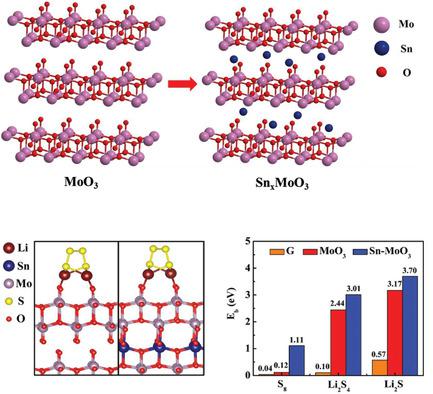当前位置:
X-MOL 学术
›
Adv. Energy Mater.
›
论文详情
Our official English website, www.x-mol.net, welcomes your
feedback! (Note: you will need to create a separate account there.)
Tin Intercalated Ultrathin MoO3 Nanoribbons for Advanced Lithium–Sulfur Batteries
Advanced Energy Materials ( IF 24.4 ) Pub Date : 2018-12-27 , DOI: 10.1002/aenm.201803137
Weiwei Yang 1 , Jiewen Xiao 1 , Yang Ma 1 , Shiqiang Cui 1 , Peng Zhang 1 , Pengbo Zhai 1 , Lingjia Meng 2 , Xingguo Wang 1 , Yi Wei 1 , Zhiguo Du 1 , Bixuan Li 1 , Zhibo Sun 1 , Shubin Yang 1 , Qianfan Zhang 1 , Yongji Gong 1
Advanced Energy Materials ( IF 24.4 ) Pub Date : 2018-12-27 , DOI: 10.1002/aenm.201803137
Weiwei Yang 1 , Jiewen Xiao 1 , Yang Ma 1 , Shiqiang Cui 1 , Peng Zhang 1 , Pengbo Zhai 1 , Lingjia Meng 2 , Xingguo Wang 1 , Yi Wei 1 , Zhiguo Du 1 , Bixuan Li 1 , Zhibo Sun 1 , Shubin Yang 1 , Qianfan Zhang 1 , Yongji Gong 1
Affiliation

|
Heteroatom doping strategies have been widely developed to engineer the conductivity and polarity of 2D materials to improve their performance as the host for sulfur cathode in lithium–sulfur batteries. However, further improvement is limited by the inhomogeneity and the small amount of the doping atoms. An intercalation method to improve the conductivity and polarity of 2D‐layered α‐MoO3 nanoribbons is developed here, thus, resulting in much improved electrochemical performance as sulfur host with better rate and cycle performance. The first principle calculations show that the binding energy of MoO3 and lithium polysulfides, lithium sulfide and sulfur is significantly improved after Sn intercalation. The Sn0.063MoO3‐S cathode delivers an initial specific capacity of 1390.3 mAh g−1 at 0.1 C with the Coulombic efficiency up to 99.7% and shows 79.6% retention of the initial capacity over 500 cycles at 1 C rate with a capacity decay of 0.04% per cycle. This intercalation method provides a new strategy to engineer the electrochemical properties of 2D materials.
中文翻译:

用于高级锂硫电池的锡插层超薄MoO3纳米带
杂原子掺杂策略已得到广泛开发,旨在设计2D材料的电导率和极性,以改善其作为锂硫电池中硫阴极主体的性能。然而,进一步的改进受到不均匀性和少量掺杂原子的限制。插层的方法来提高二维层状α-的MoO的导电性和极性3个纳米带这里开发的,因此,产生显着改善的电化学性能如硫主机具有更好的速率和循环性能。第一原理计算表明,Sn嵌入后,MoO 3与多硫化锂,硫化锂和硫的结合能显着提高。锡0.063 MoO 3‐S阴极在0.1 C时提供的初始比容量为1390.3 mAh g -1,库仑效率高达99.7%,并在1 C速率下以500个循环显示了79.6%的初始容量保留率,每个循环的容量衰减为0.04% 。这种插层方法提供了一种新的策略来设计2D材料的电化学性能。
更新日期:2018-12-27
中文翻译:

用于高级锂硫电池的锡插层超薄MoO3纳米带
杂原子掺杂策略已得到广泛开发,旨在设计2D材料的电导率和极性,以改善其作为锂硫电池中硫阴极主体的性能。然而,进一步的改进受到不均匀性和少量掺杂原子的限制。插层的方法来提高二维层状α-的MoO的导电性和极性3个纳米带这里开发的,因此,产生显着改善的电化学性能如硫主机具有更好的速率和循环性能。第一原理计算表明,Sn嵌入后,MoO 3与多硫化锂,硫化锂和硫的结合能显着提高。锡0.063 MoO 3‐S阴极在0.1 C时提供的初始比容量为1390.3 mAh g -1,库仑效率高达99.7%,并在1 C速率下以500个循环显示了79.6%的初始容量保留率,每个循环的容量衰减为0.04% 。这种插层方法提供了一种新的策略来设计2D材料的电化学性能。

































 京公网安备 11010802027423号
京公网安备 11010802027423号